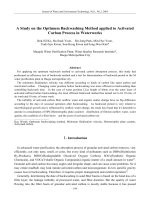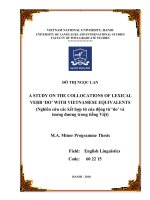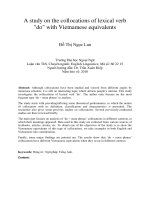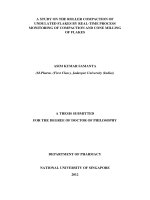A study on the side spray fluidized bed processor with swirling airflow for granulation and drug layering
Bạn đang xem bản rút gọn của tài liệu. Xem và tải ngay bản đầy đủ của tài liệu tại đây (2.14 MB, 181 trang )
A STUDY ON THE SIDE-SPRAY FLUIDIZED BED
PROCESSOR WITH SWIRLING AIRFLOW FOR
GRANULATION AND DRUG LAYERING
WONG POH MUN
B.Sc. (Pharm.) 1
st
Class Hons.,
National University of Singapore
A THESIS SUBMITTED FOR THE DEGREE OF
DOCTOR OF PHILOSOPHY
DEPARTMENT OF PHARMACY
NATIONAL UNIVERSITY OF SINGAPORE
2013
DECLARATION
I
ACKNOWLEDGEMENTS
I would like to express my highest gratitude to my supervisors, Assoc Prof Paul
Heng Wan Sia and Assoc Prof Chan Lai Wah for their supervision, advice and
guidance during the course of my study. Their motivation and guidance helped
me tremendously in the completion of this study and preparation of the thesis.
I would also be grateful to Dr. Celine Valeria Liew for her invaluable advice and
help during my candidature.
I am also indebted to National University of Singapore for the kind award of NUS
Research Scholarship that had supported me during my candidature. I would also
like to express my thanks to the Department of Pharmacy and its administrators
for the support during my candidature.
I would like to express my special thanks to Ms Teresa Ang and Ms Wong Mei
Yin for their ready assistance.
I would like to thank my helpful and supportive colleagues and friends in GEA-
NUS Pharmaceutical Processing Research Laboratory. The quality time that we
spent for discussions, exchanging opinions was one of the best moments I had
during my candidature.
Finally, I am grateful to my family for their support and understanding during my
candidature. I would like to express my appreciation to my wife, Siew Teng, for
being a supportive and patience partner.
Poh Mun, 2013
II
Tableofcontents
Summary V
List of tables VIII
List of figures X
List of symbols and abbreviations XIII
I. Introduction 2
A. Background 2
A.1. Granulation 2
A.1.1. Dry granulation 3
A.1.2. Wet granulation 4
A.2. Particle coating 10
B. Types of fluidized bed processor 12
B1. Top-spray fluidized bed processor 13
B2. Bottom-spray fluidized bed processor 15
B3. Side-spray fluidized bed processor 16
C. Factors influencing fluidized bed granulation and product quality 18
C.1. Effect of raw materials on granulation and coating 18
C.1. Effect of process parameters on granulation and coating 28
D. Fluidized bed processor with swirling airflow- FlexStream
TM
fluidized bed
processor 34
E. Design of experiments 40
II. Hypothesis and objectives 44
A. Hypothesis 44
B. Objectives 46
III. Materials and methods 50
A. Materials 50
B. Methods 50
B.1. Granulation process 50
B.2. Design of experiment (DOE) 56
B.3. Preparation of coating solution 59
B.4. Drug layering of non-pareil beads 61
B.5. Recording of particle movement 63
III
B.6. Size analysis 64
B.7. Assessment of flow properties and compressibility 66
B.8. Shape analysis 67
B.9. Determination of friability 68
B.10. Determination of density 69
B.11. Measurement of coating formulation viscosity 69
B.12. Drug content and content uniformity 70
B.13. Determination of weight gain of drug layered beads 71
B.14. Preparation of coating film 71
B.15. Optical microscopy of coating film 72
B.16. Scanning electron microscopy of drug layered beads 72
B.17. Statistical analysis 72
IV Results and discussion 76
Part A. Examination of the particle movement in FS
processor 76
Part B. Understanding and optimization of FS process by DOE 80
B.1. Group 1: first DOE by central composite design 82
B.2. Group 2: second DOE by Box-Behnken design 94
Part C. Comparison between FS granulation and TS granulation 98
C.1. Physical properties 98
C.1.1. Granule size and size distribution 98
C.1.2. Granule shape 105
C.1.3. Granule friability and density 106
C.1.4. Granule bulk density and flow properties 108
C.1.5. Granule compressibiliy 110
C.2. Chemical attributes 112
C.2.1. Drug content 112
C.3. Comparison of process time 113
Part D. Effects of spray rate and coating formulations on drug layering of small non-
pareil beads in FS processor 114
D.1. Effect of spray rate 115
D.2. Effect of coating formulation viscosity
116
D.3. Friability index of uncoated and coated beads 124
IV
D.4. Drug content of drug layered beads 127
Part E. Drug layering on small beads using FS processor 127
E.1. Optimization of formulation for drug layering on small beads for one-to-one
weight gain 128
E.2. Drug layering of small beads for one-to-one weight gain 129
E.3. Physical examination of drug layered beads with one-to-one weight gain 131
E.4. Chemical analysis of drug layered beads with one-to-one weight gain 133
V. Conclusion 136
VI. References 138
VII. List of publications and presentations 158
V
Summary
The use of swirling airflow in fluidized bed processor has not been fully explored
although it has been extensively studied in other industries. In an innovation to the
fluidized bed processor, the FlexStream
TM
(FS) fluidized bed processor adopted a
swirling airflow instead of employing axial airflow which is typical of a
conventional fluidized bed processor. This new FS processor is the main focus of
this study.
Two response surface approaches were employed to understand and optimize the
process of FS fluidized bed granulation. Parameters such as amount of binder
solution delivered, binder solution spray rate and distance between spray nozzle
and powder bed were studied using the central composite design while other
parameters such as inlet airflow rate, atomizing air pressure and distance between
spray nozzle and powder bed were studied using the Box-Behnken design.
Statistically significant models were developed to describe the relationship
between these parameters with some important granule properties, such as mass
median diameter, span, lumps and fines. Following from the developed models,
the process was optimized to produce granules with desired properties.
Granules prepared by the FS processor were compared with granules made by
conventional fluidized bed processor at various spray rates. Granules made by this
processor were generally smaller and possessed more medium sized granules at
higher spray rates (60 g/min to 80 g/min) compared to granules prepared by top-
spray granulation. This was brought about by the better drying capacity of the
swirling airflow in the FS
fluidized bed processor. However, under-granulation
VI
was observed for FS granulation at a low spray rate (21 g/min) but not in the top-
spray granulation.
FS
fluidized bed processor was explored for drug layering onto small beads (355 –
425 μm) by spray coating. Coating formulations containing two grades of
hydroxypropylmethyl cellulose (HPMC), HPMC E3 and HPMC VLV, were used
to layer coat small beads at different spray rates. HPMC VLV was found to be
better than HPMC E3 due to the possibility of a higher useful yield in the product.
Subsequently, prolonged small bead drug layering was carried out with HPMC
VLV as main film forming agent and metformin hydrochloride as the model drug.
One-to-one weight gain runs for the drug layered beads were completed in about
6 h without stopping the process. Examination of these drug layered beads after 6
h continuous layering found that a high useful yield (about 90 %, w/w) could be
achieved. The enhanced drying capacity with an elevated attritive condition
caused by the airflow in the FS processor and the selection of suitable coating
formulation had contributed to the good drug layering results.
Swirling airflow was found advantageous for the fluidized bed processor. The
swirling airflow had resulted in a better drying capacity for the processor and had
enabled it to tolerate higher liquid spray rates. This had translated into shorter
process time without impairing the quality of granules produced. In addition, the
higher attritive conditions caused by the swirling airflow and atomizing air had
help to reduce agglomeration in the long coating time involved for drug layering.
VII
FS processor is therefore a better alternative to the conventional top-spray
processor
VIII
List of tables
Table 1. Operating parameters employed in FlexStream
TM
granulation for Part
B. 51
Table 2. Settings of statistical designs used in Part B. 52
Table 3. Operating conditions in FlexStream
TM
and top-spray fluidized bed
granulation in Part C. 53
Table 4. Summary of calculated conditions for various granulation processes in
Part C. 54
Table 5. Design variables in Group 1 of Part B. 58
Table 6. Design variables in Group 2 of Part B. 60
Table 7. Coating formulations. 61
Table 8. Operating conditions for FlexStream
TM
fluidized bed in drug layering of
non-pareil beads. 62
Table 9. Operating conditions for AR-G2 for continuous ramp mode in Part
D. 69
Table 10. Response variables in Group 1 of Part B. 82
Table 11. Results of ANOVA and response surface modelling for Group 1 of
Part B. 83
Table 12. Descriptive statistics of the 6 centre points in the central composite
design. 84
Table 13. Optimized conditions for FS granulation process. 92
Table 14. Predicted and actual characteristics of granules prepared under
optimized conditions. 93
IX
Table 15. Response variables in Group 2 of Part B. 94
Table 16. Results of ANOVA and response surface modelling for Group 2 of Part
B. 96
Table 17. Granules properties. 100
Table 18. Bulk density, basic flowability energy and stability index of
granules. 108
Table 19. Results of T test in bulk density (BD) and basic flowability energy
(BFE) comparison of FS and TS granules. 108
Table 20. Properties of HPMC E3 and HPMC VLV. 119
Table 21. Friability index of beads. 124
Table 22. Viscosities of various formulations at 25 ⁰C. 129
Table 23. Physical characteristics of small drug layered beads with one-to-one
weight gain. 130
Table 24. Particle size and shape parameters of drug layered beads with one-to-
one weight gain. 131
Table 25. Drug content of drug layered beads. 133
X
List of figures
Figure 1. Schematic diagram of perforated side-vented pan coater. 11
Figure 2. Schematic diagrams of (a) top-spray, (b) bottom-spray, (c) side-spray
fluidized bed processors 14
Figure 3. Schematic diagram of the Precision
TM
coater. 36
Figure 4. FlexStream
TM
fluidized bed processor 37
Figure 5. Dual-fluid spray nozzle of FlexStream
TM
fluidized bed processor. 38
Figure 6. Adjustable distance (D) of side entry spray nozzle to powder bed. Spray
nozzle (a) closer to and (b) further from the powder bed. 39
Figure 7. (a) Top-view and (b) bottom-view of the gill plate in the FlexStream
TM
fluidized bed processor. 40
Figure 8. Particle movement (about 150 g non-pareil beads) in FS processor. 76
Figure 9. Particle movement (2 kg non-pareil beads) in FS processor. 78
Figure 10. Contour plots of the effects of (a) amount of binder solution delivered
and binder solution spray rate (hold value at distance between spray nozzle and
powder bed = 10 mm) on MMD; (b) amount of binder solution delivered and
distance between spray nozzle and powder bed (hold value at binder solution
spray rate= 60 g/min) on MMD; (c) amount of binder solution delivered and
distance between spray nozzle and powder bed (hold value at binder solution
spray rate= 60 g/min) on lumps (%); (d) amount of binder solution delivered and
distance between spray nozzle and powder bed (hold value at binder solution
spray rate= 60 g/min) on span. 87
Figure 11. Mean drug contents for of various size fractions and overall granule
batch for RunOrder 2, 7, 9, 11, 14 and 16 in the central composite
design. 91
XI
Figure 12. Contour plots of the effects of (a) inlet airflow rate and atomizing air
pressure (hold value at distance between spray nozzle and powder bed= 14 mm)
on MMD; (b) atomizing air pressure and distance between spray nozzle and
powder bed (hold value at inlet airflow rate= 100 m
3
/h) on lumps; (c) inlet airflow
rate and atomizing air pressure (hold value at distance between spray nozzle and
powder bed= 14 mm) on span; (d) inlet airflow rate and atomizing air pressure
(hold value at distance between spray nozzle and powder bed= 10 mm) on
fines. 98
Figure 13. Relative weights of different FS and TS granules at spray rate of (a) 21
g/min, (b) 60 g/min, (c) 80 g/min and (d) 100 g/min. 102
Figure 14. Scanning electron micrographs of FG and TG granules (size about
500 μm) produced at various spray rates. 106
Figure 15. Compressibility of TG21, TG44, TG60, TG80, TG100, FG21, FG60,
FG80 and FG100. 110
Figure 16. Drug content of FS granules and TS granules at binder solution spray
rate of 60 g/min. Each column represents a granule batch in the triplicate assay.
Dotted line indicates the theoretical drug content. 111
Figure 17. The effects of spray rate on (a) coating yield, (b) fines, (c)
agglomeration and (d) useful yield with coating formulations F1 and
F2. 116
Figure 18. Shear rate versus shear stress for F1 and F2 coating formulations at
25 °C. 119
Figure 19. Effect of temperature on flow time of HPMC E3 formulation and
HPMC VLV formulation. 121
Figure 20. Dried films of (a) HPMC E3 formulation, F1 without metformin
hydrochloride, (b) HPMC VLV formulation, F2 without metformin hydrochloride,
(c) HPMC E3 formulation, F1, (d) HPMC VLV formulation, F2 (e) HPMC E3
formulation, F1, under microscope (f) HPMC VLV formulation, F2, under
microscope. 125
Figure 21. Drug contents of drug layered beads at various spray rates with F1 and
F2 coating formulations. 127
XII
Figure 22. Scanning electron micrographs of whole (a) uncoated bead, (b) drug
layered bead, and cross-section (c) uncoated beads and (d) drug layered
beads. 132
XIII
List of symbols and abbreviations
A Area
ANOVA Analysis of variance
BFE Basic flowability energy
C1 Drug layered beads batch 1
C2 Drug layered beads batch 2
C3 Drug layered beads batch 3
DOE Design of experiment
D-value Desirability value
D
10
Particle size at the 10
th
percentiles of the cumulative
undersize distribution of the particles
D
25
Particle size at the 25
th
percentiles of the cumulative
undersize distribution of the particles
D
50
Particle size at the 50
th
percentiles of the cumulative
undersize distribution of the particles
D
75
Particle size at the 75
th
percentiles of the cumulative
undersize distribution of the particles
D
90
Particle size at the 90
th
percentiles of the cumulative
undersize distribution of the particles
FS FlexStream
TM
HPMC Hydroxypropylmethyl cellulose
MMD Mass median diameter
P Perimeter
PRESS Prediction sum of square
PVP Polyvinylpyrrolidone
RSA Response surface approach
SI Stability index
XIV
TS Top-spray
UC Uncoated beads
W
after
Weight of granules retained on the 180 μm aperture size
sieve after friability test
W
before
Weight of granules retained on the 180 μm aperture size
sieve before friability test
W
D
Weight of drug layered beads
W
F
Final weight of drug layered beads
W
f
Weight of collected product
W
fines
Weight of the fines
W
fraction
Weight of granules in the specific fraction
W
i
Weight of load used for granulation
WIR Water input rate
WIR
net
Net water input rate
W
lumps
Weight of the lumps
W
N
Weight of non-pareil beads
W
s
Dry weight of solids added via the spray solution
W
T
Theoretical final weight of the drug layered beads
W
total
Total weight of the particles
X
1
Amount of binder solution delivered
X
2
Binder solution spray rate
X
3
Distance between spray nozzle and powder bed
X
4
Inlet airflow rate
X
5
Atomizing air pressure
X
6
Distance between spray nozzle and powder bed
XV
β
0
Constant in quadratic equation for response surface
modelling
β
1
Coefficient for the linear terms X
1
β
2
Coefficient for the linear terms X
2
β
3
Coefficient for the linear terms X
3
β
4
Coefficient for the linear terms X
4
β
5
Coefficient for the linear terms X
5
β
6
Coefficient for the linear terms X
6
β
11
Coefficient for the squared terms of X
1
2
β
22
Coefficient for the squared terms of X
2
2
β
33
Coefficient for the squared terms of X
3
2
β
44
Coefficient for the squared terms of X
4
2
β
55
Coefficient for the squared terms of X
5
2
β
66
Coefficient for the squared terms of X
6
2
β
12
Coefficient for the interaction terms of X
1
X
2
β
13
Coefficient for the interaction terms of X
1
X
3
β
23
Coefficient for the interaction terms of X
2
X
3
β
45
Coefficient for the interaction terms of X
4
X
5
β
46
Coefficient for the interaction terms of X
4
X
6
β
56
Coefficient for the interaction terms of X
5
X
6
ρ
b
Bulk density
ρ
t
Tapped density
1
PART I.
INTRODUCTION
2
I. Introduction
A. Background
The production of solid dosage forms in the pharmaceutical industry is known to
be a process that involves multiple stage unit processes such as weighing and
dispensing of ingredients, blending, granulating, drying, compacting and coating.
All of these processes could impact final product quality differently. Among all
these processes, granulation and coating are the two unit processes of particular
interest in this project. The reason for this is because properties of the granules
were reported to have significant effects on the quality of the resultant tablets
(Forlano and Chavkin, 1960; Marks and Sciarra, 1968; Wikberg and Alderborn,
1992). Similarly, coating is the final unit process to be applied to the product and
therefore it is important to maintain the product quality. If the coat application is
not properly carried out, the function of the coat could be altered and therefore,
affect the quality of the product.
A.1. Granulation
Granulation is defined as a process for gathering small discrete particles into
larger, coherent aggregates or granules, in which the component particles can still
be identified (Ennis and Litster, 1997). Granulation is widely used in the
pharmaceutical industry. It usually starts after dispensing and dry blending of
formulation components into a uniform mix, followed by conversion into
aggregates or granules which are to be used as tablet or capsule feed. Granules
have several advantages over powders, such as superior drug uniformity or drug
distribution, better flow properties, less dust generation, less segregation of the
3
ingredients, better compaction characteristics, higher bulk density and better
appearance (Parikh, 2005).
Granulation may be carried out by a dry or wet granulation procedure.
A.1.1. Dry granulation
As the term suggests, liquid is not required in dry granulation. The binder, when
needed, is usually added as a dry powder and blended with the other
pharmaceutical ingredients. Thus, drying is avoided and this leads to savings in
energy cost and process time. As a consequence, dry granulation is often the more
preferred method where possible as it is easier, more direct and cost saving.
Furthermore, it is ideal for pharmaceutical products containing heat or moisture
sensitive actives because the process does not involve moisture addition and heat.
Dry granulation involves compression of the powder mixture by slugging or roller
compaction (Miller and Sheskey, 2007). Slugging is carried out by feeding
powder into a heavy duty compression machine, where the powder will be
compressed into large compacts or slugs, typically with a diameter of 2 – 3 cm
and thickness of about 1 cm. These slugs are subsequently milled and fractionated
for further processing into capsules or tablets. With the roller compactor, feed
powder is forced through a pair of counter-rotating rollers to form flakes. Similar
to slugging, the flakes formed would be milled and fractionated accordingly
before subsequent processes. However, success of the dry granulation process is
limited by the suitability of the material properties of the feed powder mixture.
The powder mixture needs to possess adequate compressibility to enable dual
4
compaction cycles for it to be a good candidate for dry granulation. Unfortunately,
there are not many actives and pharmaceutical ingredients that could easily meet
this requirement satisfactorily. Hence, there is a general preference for the
adoption of wet granulation by the pharmaceutical industry.
A.1.2. Wet granulation
As opposed to dry granulation, a liquid is used in the wet granulation process. The
liquid could be either water or organic solvent such as alcohol but concerns of
environmental pollution, explosion hazards, solvent toxicity and high cost have
reduced considerably the use of organic solvents (Hogan, 1982). When required,
the binder could be incorporated by dissolving it in the granulating liquid. Despite
literature reports that binder content variation in granules could result in granules
of different properties (D'Alonzo et al., 1990; Paris and Stamm, 1985), it will not
be of great concern to the pharmaceutical product manufacturer, as long as the
overall product quality is not adversely affected.
In wet granulation, four key mechanisms or stages are identified: wetting and
nucleation, coalescence, consolidation and attrition or breakage (Ennis, 2010). In
the first stage, the moistening liquid is sprayed as atomized droplets on to the
powder mixture to be granulated. Wetting of the powder mixture promotes
agglomeration, first by nucleation of the fine particles. Nucleation is the initial
coalescence of primary particles in close vicinity of where the binding liquid
droplets impact. In the second stage, collision of the coalesced particles occurs to
form larger entities (aggregates). In some cases, aggregate growth can occur by
layering, where fine primary particles are attached to a larger aggregate. Shear
5
forces in the agitated bed enable the consolidation and growth of the aggregates to
form granules. The consolidation process affects some granule properties such as
internal granule voidage and hence, granule porosity, mechanical strength and
dissolution rate. Along with granule growth, the granules are also subjected to
attrition due to their collision and impact on the surfaces of the processor.
Attrition is usually more pronounced when granules are dried and the outcome is
the generation of fines. Therefore, granulation can be viewed as a process with a
balance between granule growth and granule attrition. For a successful
granulation process, the former has to predominate.
Wet granulation can also be carried out by wet massing using an impeller or
extruder and drying by adopting the fluidized bed concept. All of the
aforementioned key granulation mechanisms may occur simultaneously, albeit at
varying rates, in the wet granulation process. However, due to differences in the
granulator employed, some of the mechanisms could be more dominant than the
others. For example, consolidation is more dominant in high shear granulation or
extrusion granulation than fluidized bed granulation due to the direct force
applied by the impeller or extruder. A brief summary of the more common
granulation methods used by the pharmaceutical industry will be discussed with
the expected granule characteristics.
Low and high shear granulation
Low and high shear granulation methods are classified based on agitation forces
in the granulators involved. Low shear granulators are designed with lower
6
agitator speeds, sweep volumes or bed pressures and generate relatively lower
shear rate than high shear granulators and extruders (Chirkot and Propst, 2005).
Examples of low shear granulators are ribbon and paddle blenders, planetary
mixers, orbiting screw granulators, sigma blade mixers and rotating-shape
granulators, and the physical designs of these processors may be very different. In
contrast, high shear granulators are generally designed with the basics of a mixer
bowl, a main impeller and a chopper. The main impeller can rotate at high speeds
to provide a high shear environment during the granulation process while the
main function of the chopper is to breakdown any incidental large wet clumps
during the process (Gokhale and Trivedi, 2010). Granules produced by high shear
granulation were reported to produce harder tablets than granules produced by
low shear granulation (Shiromani and Clair, 2000). In general, bulk density values
of low shear granules are intermediate in value between fluidized bed and high
shear granules (Chirkot and Propst, 2005).
Extrusion granulation
Extrusion spheronization is usually used to produce uniformly sized spherical
granules or pellets. It is considered a specialized form of the granulation
technology as the process does fit into the definition of granulation, where fine
particles are converted into larger aggregates. However, extrusion spheronization
is a multiple-step process that is more labour and time intensive than other
commonly used granulation technologies (Mehta et al., 2005). Nonetheless,
extrusion spheronization has the advantage of being able to incorporate high








